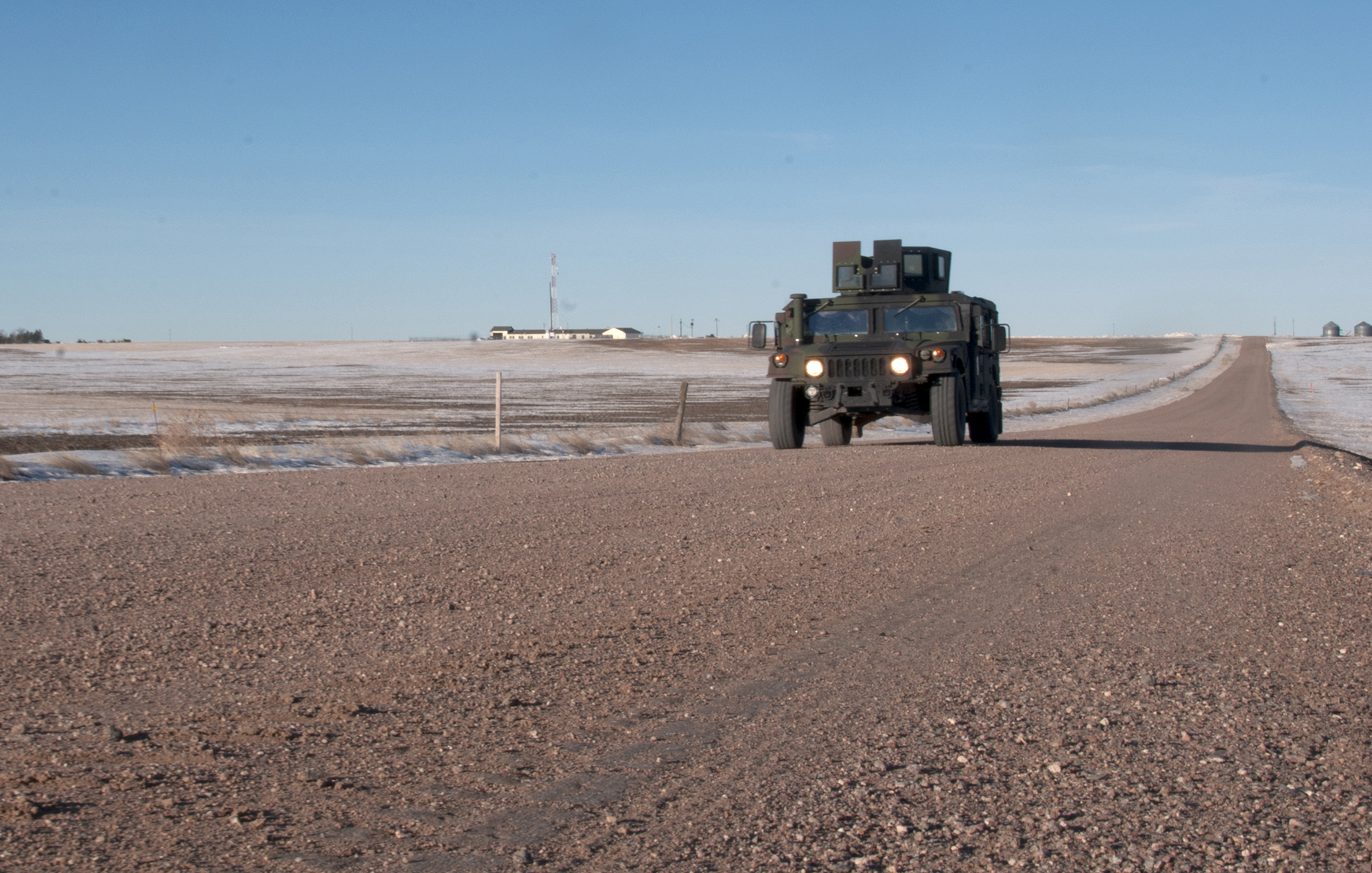Fe Warren Missile Sites - The history of nuclear weapons in Wyoming is closely tied to F. E. Warren Air Force Base, which in turn is linked to the global development of rocket and nuclear power. If Wyoming were a nation, Warren AFB in Cheyenne would make it one of the largest nuclear powers in the world. Wyoming's history with nuclear weapons is closely tied to global Cold War tensions and the development of missile-based nuclear weapons systems.
The base began life as Fort D.A. Russell in 1867. Fort Russell eventually became one of the largest cavalry posts in the country. In the late 19th century, it was home to the famous Buffalo Soldiers of three African-American regiments: the 9th and 10th Cavalry and the 24th Infantry.
Fe Warren Missile Sites

In 1876, troops from Ft. Russell fought the Sioux in the same war that General George A. Custer had his fate at the Little Big Horn. In 1901, troops from the fort served in the Philippines. And during the Mexican Revolution from 1913 to 1916, the fort's artillery units were positioned along the US-Mexico border.
Mw Holds Story Telling Event > F.e. Warren Air Force Base > News
John "Black Jack" Pershing - then a Captain, later General of the Armies in World War I - was stationed at Ft. Russell for a moment. Pershing married the daughter of Wyoming US Senator Francis E. Warren, for whom the fort was later renamed. F.E. Warren AFB was transferred to the Air Force in 1947 and is the oldest continuously active base in that service branch. (Netherlands)
The base of F.E. Warren Air Force has no planes. It is, however, one of the largest missile command bases in the country.
During World War II, Germany launched the first missile strikes in history against England with the famous V-1 and V-2 missiles. Although US efforts to develop pilotless aircraft had stalled before then, the German success inspired intense further research, producing some 5,000 JB-2s (JB for "jet bomb"). These weapons were not ready in time to be deployed against Germany, but work continued on unmanned aerial vehicles and eventually intercontinental ballistic missiles (ICBMs).
After the war, the federal government awarded Convair a contract for a rocket that could launch a 5,000-pound warhead at 5,000 feet at any target 1,500 to 5,000 miles away. This was a call for a giant leap forward in distance and accuracy. The range of the V-2 was only about 200 miles.
Missile Operations Instructor To Afrotc Instructor > F.e. Warren Air Force Base > News
Immediately after the atomic bomb was dropped on Hiroshima, the US military proposed putting nuclear weapons on missiles. However, this proved extremely difficult to achieve. In November 1952, the US achieved a major breakthrough in thermonuclear research - the hydrogen bomb - which promised lighter and more powerful warheads. Missile weight can now be reduced and missiles don't need to be as accurate.
The development of missiles and nuclear weapons received another boost in the mid-1950s during the "missile gap" debate, when Democrats claimed—inaccurately, as it turned out—that the Eisenhower administration had allowed the Soviet Union to develop a significant advantage. ICBM numbers. In a speech on the floor of the United States Senate on August 14, 1958, Massachusetts Senator John F. Kennedy argued that the Eisenhower administration had allowed the United States' defenses to deteriorate. "The most critical years of the gap," Kennedy said in his speech, "appear to be 1960-1964 ... our military position today is measured in terms of the gaps -- the missile gap, the space gap, the limited war gap." (Bye)
In the case of missiles, at least, this concern has been exaggerated. Instead of having thousands of operational missiles, the Soviets actually only had four prototypes. The fear generated by these claims encouraged heavy spending and accelerated the development of missiles and nuclear weapons, fueling the nuclear arms race.

The development of missiles and weapons together overcame a series of technical, bureaucratic, and military obstacles during the 1950s. The Air Force won the bureaucratic battles to command ballistic missile squadrons. Two ICBMs - Atlas and Titan - were deployed. In August 1957, the Air Force selected Warren Air Force Base as the first operational base for Atlanta and Lowry Air Force Base in Colorado as the first Titan site.
The Air Force Found Airmen Boozing It Up In A Nuclear Missile Alert Facility In Wyoming
The first deployment of the Atlas Missile Squadron was established in F.E. Warren in 1960. Missiles scattered over cattle country in southeastern Wyoming, western Nebraska, and northeastern Colorado.
Between 1963 and 1965, the Atlas missiles were phased out and replaced by Minuteman I missiles, and later by Minuteman III missiles between 1972 and 1975.
The deployment of the first 24 Atlas missiles did not create much controversy in Cheyenne. The base has always been considered a good neighbor in southeastern Wyoming, and the missiles and the federal spending that came with them provided a significant economic boost at a time of decline for the state. Between 1959 and 1965, more than 50,000 people immigrated from Wyoming, a population loss offset by an excess of births over deaths. Things would have been worse had it not been for the influx of money, military personnel and their families that together turned the base into a major ICBM hub. (Larson)
The Atlas missiles have just been installed and are beginning to be dismantled for the more advanced Minuteman missile. By 1963, Warren controlled 200 Minuteman 1B missiles, scattered in silos across the plains of southeastern Wyoming, southwestern Nebraska, and northeastern Colorado. Each missile carried a thermonuclear warhead, capable of releasing an explosive force - known as a "throwing weight" - of about 1.2 megatons. The bomb that destroyed Hiroshima is estimated at 15 kilotons. Thus, a single Minuteman warhead accumulated the power of nearly 100 Hiroshima bombs.
Uso Provides Comforts Of Home > F.e. Warren Air Force Base > News
The first Minuteman missiles at Warren were marvels of the time, potentially capable of delivering their bombs less than half a mile from their target after traveling thousands of miles through the atmosphere and space. They brought the first recognizable modern computer guidance systems. Strategic nuclear weapons tactics gradually diverged between the US and the USSR. US forces opted for a lower "launch weight" that could be dropped more accurately, while the Soviets built larger bombs. One "probably" Soviet weapon is believed to have been a 25-megaton warhead. Most US nuclear weapons were between a third and a megaton, but even the smallest of these had ten times the explosive power of the Hiroshima bomb.
The missiles were placed in silos, the bottom of which is about 170 feet below the surface of the ground. One of the problems with the Minuteman was that the military could not be absolutely sure that it would work when fired from a silo. "Twice a year," the commander of the site activation task force told F.E. Warren in 1983, “one of the missiles—we never know which one—comes out of its silo and is tested at Vandenburg Air Force Base in California. Our success rate is very good." (Whipple 1983) But Vandenburg launches then and now are from above-ground launch test facilities. One reviewer noted that a Minuteman has never been successfully released from an operational silo. The Air Force tried it four times, then gave up (Fallows).
Meanwhile, in November 1982, then-President Ronald Reagan announced in November of that year that he planned to deploy 100 new MX missiles in hardened silos in rural southeastern Wyoming.

The MX was the pinnacle of Cold War land-based nuclear weapons. It was a "multiple independently guided re-entry vehicle" (MIRV) with ten nuclear warheads that could be launched within 120 meters of its target. Each warhead carried about a third of a megaton of explosive power.
Air Force Announces Gbsd Locations At Three Existing Missile Bases, Including F.e. Warren
According to the Scowcroft Commission, established in January 1983 to study the country's strategic modernization needs, the MX “is a four-stage intercontinental ballistic missile capable of launching up to ten high-precision, independently targetable nuclear warheads. The rocket is about 71 feet long, 92 inches in diameter, and weighs 195,000 pounds…
"In contrast, the Minuteman III missile is 60 feet long with a first stage diameter of 66 inches and weighs 78,000 pounds." (FEIS 1984).
The trip from MX to Cheyenne was rough. The Carter administration in 1979 authorized the study of a basic system called "horse racing." This was a plan in which the 200 nuclear missiles would be loaded onto trucks and spread over a large road network—which would have to be rebuilt—connecting much of Utah and much of Nevada. Along the new roads, the Air Force would also build 4,600 concrete shelters from which missiles could be launched.
At word of a Soviet attack, trucks loaded with missiles would leave for these launchers, so the Soviets would not know which were occupied and which were not. The assumption was that in the confusion at least some of the missiles would survive an initial attack, making themselves available for a counterattack.
The Missile Silo Remains An Important Part Of National Defense
This plan was intended to solve one of the biggest problems in combat strategy in nuclear war, the question of the "survivability" of a retaliatory force in the face of a first strike. Ground-based missiles were only part of the answer
Minuteman 3 missile sites, icbm missile sites, missile silo sites, missile sites, minot missile sites, atlas missile sites, minot afb missile sites, titan ii missile sites, fe warren, atlas missile silo sites, missile sites for sale, minuteman missile sites
0 Comments